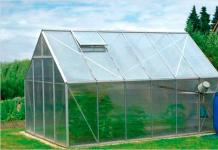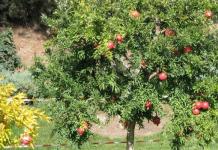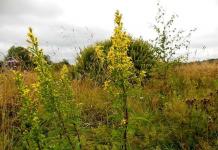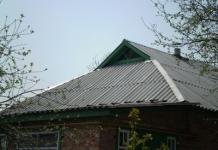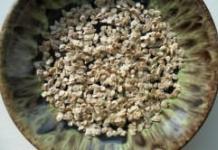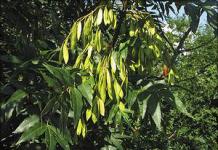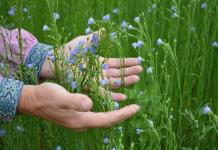The very tall stems of amaranth are perceived by many as weeds, although this flower is cultivated and is even used in cooking.
Let's see what is special about this plant and how to grow amaranth in your own flower bed.
Amaranth: plant description

By appearance amaranth is a very tall plant with a rather thick stem, which is covered with many leaves and crowned with a paniculate straight inflorescence (in some varieties of amaranth, the inflorescence may lean down).
The average height is 120 cm, although ornamental varieties rarely stretch even up to a meter in height. The stems may vary in branching, and the leaves may be presented in an oval, diamond-shaped or elongated shape.
When amaranth was introduced to European countries, it began to be used as a fodder crop for animals and as an ornamental flower that can please with a huge variety of colors:
- golden;
- red;
- purple;
- green;
- violet;
- a mixture of all the above shades.
After flowering on amaranth, fruits are formed that are in the form of boxes containing seeds. After full ripening, the seeds are harvested and used either for sowing the next year or for food. In warm climates, self-seeding of amaranth is possible.
Did you know? Amaranth is an excellent raw material for teas and salads, but adult plants in the beds are not suitable for this purpose. For food purposes, it is necessary to create separate dense crops, which, upon reaching a height of 20 cm, are completely cut off and sent for drying or cooking.
Climatic conditions for the successful growth of amaranth
Amaranth is an undemanding plant in planting, but not all climatic conditions are suitable for its cultivation. In particular, most varieties in hot Asian countries located at the level of the equator are able to grow as a perennial plant that does not require annual sowing. 
But in the climatic conditions of our region, this plant is grown only as an annual, since neither it nor its seeds are able to endure wintering in the open field. Nevertheless, already in the spring in the southern regions of our country, amaranth is quite acceptable to sow seeds directly into open ground.
Amaranth sowing technology
Amaranth can be grown using different technologies, the choice of which depends on climatic conditions. If you live in a region where the heat comes from mid-spring, you can sow amaranth seeds directly into the soil without any problems.
But if real warmth begins to please only from the first summer month, it is better to sow the seeds in boxes or peat pots for seedlings. For the northern regions, we recommend growing amaranth through seedlings.
Reproduction of amaranth by direct sowing
 Planting amaranth with seeds involves preliminary preparation of the soil. First of all, it is worth waiting for the end of April, when the earth at least 4-5 centimeters in the middle of the day will warm up to 10 ° C and above.
Planting amaranth with seeds involves preliminary preparation of the soil. First of all, it is worth waiting for the end of April, when the earth at least 4-5 centimeters in the middle of the day will warm up to 10 ° C and above.
Also, the soil must be fertilized so that the flower quickly grows. To do this, it is recommended to use mineral fertilizers (you can choose complex fertilizers), adding 30 g of the substance per square meter of flower garden area.
Important! When fertilizing the soil for sowing amaranth seeds, you should not add a lot of nitrogen, since during growth this plant is able to convert nitrogen into nitrates that are dangerous to humans. After the amaranth stems stretch up to 20 cm in height, they must be fed with nitrogen fertilizer, but for the above reasons, only half of the rate indicated on the package should be used.
When sowing for amaranth, it is necessary to make furrows at a depth of 1.5 cm and lower the seeds one by one. The earth at the time of sowing should be loose and moist. It is good if between the plants in one furrow there will be a space of 7 to 10 cm (if the variety is tall, more can be) and about 45 cm in one row.
Shoots are usually visible on the 7-10th day. If they are thick, you can immediately break through the plants and at the same time loosen the soil to stimulate further growth.
A feature of amaranths is that if they are sown at the end of April and grow rapidly, then the weeds lose the opportunity to "take over" the flower bed around the flowers. But if you miscalculate with the timing, the weeds can grow first and the flower bed will have to be weeded very often. After such sowing, full ripening of seeds occurs only after 3.5 months.
Sowing seeds for seedlings
 How to grow amaranth using seedlings? For this purpose, seeds are sown in the second half of March, for which plastic boxes, ordinary flower pots or special peat pots are used.
How to grow amaranth using seedlings? For this purpose, seeds are sown in the second half of March, for which plastic boxes, ordinary flower pots or special peat pots are used.
After sowing, the pots are placed on warm windowsills with good lighting. It is very important that the room temperature does not fall below 22°C. Watering should be from a sprayer.
Already within a week, the first shoots appear, which need to be given another 3-4 days and thinned out, removing all weak shoots. After the appearance of three leaves on the seedlings, it can be transplanted into individual pots. If you use peat pots for this (diameter - 12 cm), they can be dug into the ground along with the plant.
How to plant amaranth?
In this section, we will mainly talk about planting seedlings, since after sowing the seeds, caring for amaranths will consist of removing weeds and watering. But with seedlings you have to be a little smarter.
When to plant amaranth
Planting amaranth seedlings should begin when the threat of spring frosts has completely passed and the soil temperature throughout the day will remain within 10 ° C and above. Often this procedure should be planned for the middle or end of May. 
The plant is planted in light and nutritious soil with low acidity (it is better if it is mixed with limestone). You can also prepare under the soil drainage.
As a fertilizer for amaranth seedlings, nitroammofoska is used (no more than 20 g per square meter). As for choosing a place for a flower bed with amaranths, it should be well lit by the sun.
Important! Amaranth can hardly be called a whimsical plant, but it can be destroyed by low temperatures and waterlogged soil - damage appears on the roots and stems that begin to rot.
Landing technology
The amaranth seedling itself does not need to be prepared when planting in the ground. It is planted in rows, between which it is necessary to leave a space of at least 45 cm, and for tall large varieties - 70 cm. There should be a space of 30 cm between individual plants.
 Small holes are being prepared for planting, in which, after the application of nitroammophoska, fertilizer is not required. Seedlings do not need to be lowered too low into the hole so that they do not rot later.
Small holes are being prepared for planting, in which, after the application of nitroammophoska, fertilizer is not required. Seedlings do not need to be lowered too low into the hole so that they do not rot later.
Until it grows, the soil in the flower bed must be watered regularly. If it suddenly starts to get cold, a flower bed with amaranths can be covered with a film for the night (but in the morning the shelter must be removed so that the seedlings do not suffocate).
Plant care rules
Most of all, amaranth requires care only after transplanting seedlings into open ground. It has to be watered regularly, weeding around it weeds. But as soon as the seedlings begin to grow, the weeds in the flower bed with amaranths will practically disappear, as it is difficult for them to get along with a large, strong flower.
Did you know? With good care, amaranths grow very rapidly. In just one warm day, when the plant is well lit by the sun, it can stretch up to 7 cm.
As for watering, they are important only during the first month. In the future, the seedlings will take root well to a depth of up to a meter and will not require watering. An exception may be a dry summer without rain.
(A. caudatus). The main decoration of this plant is the brightly colored variegated leaves of green, yellow and red, because of which it got its specific name. In Russian, the flower is most often found under its scientific name, while in English sources it has many everyday synonyms - "Joseph's Coat" - in honor of the biblical Joseph, who predicted seven plagues of Egypt and, according to legend, walked in colorful clothes ), "fountain flower" (Fountain Plant), "summer poinsettia" (Summer Poinsettia), "Chinese spinach" (Chinese Spinach, more related to salad varieties).Some sources provide information on various botanical varieties, subspecies and forms of tricolor amaranth such as diff. willow, diff. red-green, red form, etc. However, according to the modern classification, they are all synonyms and are not distinguished separately from the main species.
Amaranth tricolor in nature.
The plant originates from the tropical regions of Asia, where it is one of the most common crops whose leaves are used as food. Cultivation occurred in ancient times and the wild ancestor of the plant is not exactly known. This fast growing annual can reach 80-120 cm in height. The stem is green or reddish, strong, erect, usually highly branched. The shape of the bush is spherical, pyramidal, compact or loose, up to 70 cm in diameter. The leaves are smooth, on long petioles, reach 15 cm in length and up to 10 cm in width. The shape is very diverse - elongated, oval, wide-elliptical. The arrangement on the stem is next in a spiral, the leaf blade is whole, the edge is most often wavy. The flowers are not decorative green or red, small, collected in dense panicles in the axils of the leaves and on the apical inflorescence. Seeds are small, 1-1.5 mm., shiny, black or brown, almost round.Amaranth tricolor in culture.
As a vegetable plant, this species, with the help of man, has spread widely in regions with a warm climate and a large number of sunny days, especially in Asia and Africa. Decorative leafy varieties cover a wider area. In the southern regions of Russia, the plant develops well when sown in open ground and is often renewed by self-sowing for many years. In the middle lane, guaranteed results can only be obtained in hot summers, or by growing it through seedlings. Amaranth tricolor is almost unknown as a pot crop, but on a sunny windowsill or well-lit balcony, it will grow without any problems and will undoubtedly become one of the most striking decorations of the flower collection.In the State Register of Breeding Achievements for 2014, domestic varieties of tricolor amaranth were not registered.
There is also no active selection abroad and there are less than a dozen old varieties on the market, which are mainly improved natural varieties (sellers offering seeds for sale are indicated in brackets):
- "Aurora" ("Aurora") - a variety with a bright yellow-lemon leaf color, without red pigment. It is found under the name "Kesha" (Sedek).
- "Illumination" ("Illumination") - an undersized variety, the lower leaves are dark green, the upper ones with a smooth transition of orange and red tones, the center is yellow. The most popular among Russian distributors who sell it under the name "Illumination" (Gavrish, Poisk) or "Illumination" (Russian Garden - NK).
- "Perfecta" ("Perfecta") and "Splendens" ("Splendens") are synonyms of the same variety. The leaves are long narrow with contrasting yellow and red coloration. It is sold as "Perfecta" (Prestige), "Perfection" (Gavrish), "Splendens Perfecta" (Agros).
- "Molten Fire" ("Molten Fire") - the color of the upper "cap" of the leaves is bright brick red, the lower leaves are dark green with a transition to brown. It is sold under the name "Amaranth Bicolor" (Aelita), "Glamorous Shine" (Gavrish), "Molten Fire" (Sedek).
- "Early Splendor" ("Early Splendour") - similar to the previous variety, but the tone of the upper leaves is pinkish-red. Referred to as "Earley Splendor" (Agros).
- "Flaming Fountains" ("Flaming Fountains") has narrowed leaves, the lower ones are bronze, the upper ones are scarlet.
- a mixture of varieties "Aurora", "Illumination" and "Early Splendor" is offered under the names "Brazilian Carnival" (Search), "Polovtsian Dances" (Sedek).
- "Joseph's Coat" is a synonym for the species, but not the variety. Under this name, any of the known varieties can be offered, depending on the imagination of the distributor.
Amaranth tricolor - maintenance and care.
❀ Compact varieties that do not take up much space are more suitable for growing in room culture. Tall specimens may require support. Sowing seeds can be done from March to June, which will ensure the presence of ornamental plants from early summer until late autumn. In winter, this annual is usually not grown due to lack of sunlight. The color of the leaves appears only in sufficiently intense light and with age, it turns into darker tones, usually bronze or maroon. At the age of 4 months, with the onset of the flowering phase, the plants stop active growth. Removing inflorescences can extend the growing season by another 4-10 weeks. If desired, you can leave 1-2 plants per seed, which are easily tied, as the species is self- and wind-pollinated.❀ For the full development of this flower, sufficiently high temperatures are needed. Optimal conditions are 25°C and above during the day and at least 15°C at night. Amaranth does not tolerate cold and dies even with short-term frosts. The species is so heat tolerant that it is the only edible leafy plant that survives the summer temperatures in the South Indian states.
❀ Intense lighting is required, preferably direct sun on a southern window or balcony. The amount of light determines the brightness of the color of the leaves, which lose their gloss and variegation in the shade. The plant has a pronounced phytoperiodism - a shortened daylight hours of less than 15 hours stimulates the beginning of flowering.
❀ Amaranth tricolor is less resistant to drought conditions than other species and requires regular abundant watering. The lack of water leads to the formation of dwarf specimens and earlier flowering, which reduces the decorative period of plants.
❀ The substrate for planting must be loose and well-drained. The level of soil acidity does not play a special role, since amaranth develops well in both slightly alkaline and acidic soil.
❀ The amaranth bark system is powerful, so the containers are selected sufficiently large and stable, taking into account the large size of the plants. It is better to use ceramic pots, or deep plastic boxes for annuals.
❀ Best of all, plants develop in moderately fertile soil without excess humus and organic supplements, otherwise the color of the leaves becomes less bright. The species is distinguished by a very active absorption of minerals from the soil, therefore regular fertilizing with mineral fertilizers with an approximate NPK ratio of 10:10:20 is recommended.
❀ Air humidity does not play a significant role, the plant tolerates both dry air and high humidity well.
❀ Amaranth tricolor does not reproduce vegetatively.
❀ Sowing seeds is carried out on the surface of the earth and then sprinkled with a thin layer of sand or soil, since the absence of light stimulates germination. For a more even distribution of very small amaranth seeds, they can be mixed with sand before sowing. At a temperature of 21°C and above, seedlings appear after 5-14 days. Cooler conditions significantly delay germination. The plant requires intense lighting from the first days of development, therefore, when planting early in March-April, artificial lighting is used. Amaranth does not tolerate transplanting well and it is better to sow it immediately in individual containers, or pick it up as early as possible. Pinching the growth point at a height of 10-15 cm stimulates more active branching of the stem and the formation of a denser and more voluminous plant.
❀ Of insects, the main danger is aphids and stem- and leaf-eating caterpillars, which are quite rare in apartments. Plants can also be affected by mites and insect miners, but are immune to nematodes. The species is less disease resistant than other amaranths. The main danger is the root rot of young seedlings and adult plants. The main preventive measure is the selection of well-drained soil, which provides a runoff of excess water after irrigation, and its sterilization before sowing. Leaves are occasionally affected by rust.
This is interesting:
- tricolor amaranth has a rare type of C4 photosynthesis and is distinguished by a uniquely high ability to absorb carbon dioxide from the air and convert it into biomass at high temperature and solar radiation.
The amaranth flower attracts attention with an unusual and sophisticated look due to its green-purple color. It is used in the design of flower beds, park and garden areas, making bouquets. The stem and inflorescences retain their decorative effect for a long time when dried.
Origin
The natural habitat is in India, in the vastness of China and America.
Amaranth tailed, sad and tricolor are grown as food and for decorative purposes. The peoples of the East plant tricolor amaranth as a vegetable. A long time ago, the plant began to be cultivated along with corn and legumes in Mexico and South America. Some species are grown as cereals today. And others are recognized as weeds (bluish or upturned appearance).
Spanish sailors brought the flower to the European continent. At first, it served as an ornament for flower beds, and since the 18th century it has been cultivated as a cereal and fodder crop.
Name
The name of the plant is of Greek origin, meaning "unfading flower". Amaranth is also known by other names: amaranth, velvet, cockscomb.

Description
Amaranth (Amaranthus) is a member of the Amaranth family. The amaranth bush is green, purple or purple in color, and more often combined. It is formed from smooth or branched stems, the thickness of which reaches 7-19 cm. The shape of the leaves is lanceolate, oval or diamond-shaped with the leaf base elongated into a petiole. At the top of the leaf there is a groove with a sharp point. The arrangement of the leaves is alternate. The height of the plant depends on the variety and ranges from 30 cm to 3 m.
Inflorescences-bundles of small flowers are located in the axils of the leaves. The apical inflorescences are panicles in the form of an ear. They are painted in green, crimson, purple or golden tone. Amaranth is a wind pollinated plant. The seed resembles a box. Small seeds are found in brown, white and black.
In temperate climates, amaranth is an annual. The plant is divided into fodder, vegetable, ornamental and grain species.

Sowing
Growing a flower from seeds is very simple. Seeds are planted in open ground in the final decade of April. The temperature of the top layer of soil + 10 ° allows you to start planting.
Seeds are placed in moistened grooves at a depth of 1.5 cm. Row spacings recede by 45 cm, and between grains in a row they stand 8-10 cm.
To facilitate work with a fine composition, sand or small sawdust is mixed in a ratio of 1:20. Seedlings are expected after 7-10 days. If necessary, they are thinned out, and the earth is loosened.
With later, May plantings, the destruction of weeds will be required.
Under plants that have reached a height of 20-25 cm, nitrogen fertilizer is applied, reducing the recommended dosage by half. Amaranth ripening occurs 3-3.5 months after planting.

Growing seedlings
Seedlings are planted at the end of March. This will require containers or flower pots with a depth of 10 cm. The seeds are buried in a moistened substrate by 2 cm. The containers are kept in a bright and warm place at a temperature of + 22 °. The first shoots will appear in about a week.
Weak shoots are removed and thinned out. After the formation of 2-3 full leaves dive into separate pots. To transplant seedlings into the garden, frosts must pass and the earth warms up. Most often, this time is at the end of May.

Conditions for planting in the garden
The place for amaranth is sunny with good drainage. The soil needs nutritious, with a loose structure. Amaranth is unpretentious in all respects except for low temperature and stagnant water in the ground.
Preparation consists in digging with the addition of 30 g of the mineral complex per square meter.
The amount of nitrogen should be minimal, because amaranth has the ability to process it into nitrates. In the garden, seedlings are placed at a distance of 15-30 cm. Between the rows, 45-70 cm are left free, depending on the variety. At first, the plants need regular watering.

Pests, diseases
With an excess of moisture in the soil, amaranth is affected by fungal diseases. A fungicide, such as copper oxychloride, copper sulfate, will help get rid of them.
care requirements
The plant loves light and heat, tolerant of drought. The flower requires attention only at the stage of engraftment, until active vegetation begins. In the first month, development is slow. Plants need watering, weed removal and loosening. After rooting, development accelerates and amaranth displaces weeds. A month later, the root goes deep into the ground and the amaranth no longer requires watering, only on especially dry days.
You will need to feed the plants 3-4 times with an interval of 1 month. For this, mullein (1: 5) and ash at the rate of 200 g per bucket are suitable. Fertilizers are applied in the evening after watering.
In the middle lane, amaranth will not survive even a mild winter. In autumn, at the end of the season, the bush is completely removed from the ground, the remains of the aerial part are collected and disposed of. Healthy, disease-free stems are placed on a compost heap.

Seed harvesting
To collect seeds, the largest plants should be selected. You need to wait until the lower leaves turn red, then dry out and fall off. The stem of the amaranth should turn whitish. Collection is carried out on a dry, sunny day. Panicles are cut first at the base of the stem, then at the top.
The collected material is left in a dry, ventilated place for 2 weeks. After that, the dry inflorescences are rubbed with their hands so that the seeds fall. They are sifted through a fine sieve and stored in paper packaging. Seed germination remains high for 5 years.
Existing species and varieties
More than 900 varieties of amaranth have been classified, differing in flower structure and color. The main representatives are:
- Crimson or paniculate often found in flower beds and in bouquets. The plant grows to 75-150 cm. Red-brown leaves are elongated-ovate with a pointed top. Small red or burgundy flowers form erect or lowered inflorescences. Flowering begins in June and continues until frost. The following plant forms have been bred:
Sanguineus with falling edges of inflorescences
Cruentus with drooping red panicles
Nana undersized bush not higher than 50 cm
The most popular among flower growers are undersized species with a height of 25-40 cm.
Zwergfakel and Grünefakel are distinguished by purple and dark green flowers
Roter Dam and Roter Paris with rich, red foliage and maroon buds. Stem height 50-60 cm.
Hot Biscuit is a tall species of meter height. Green leaves set off orange-red flowers.
- Dark or sad- a flower with low tillering up to 1.5 m in height. The oblong, pointed leaves are purple or green-purple in color. The vertical spikelets of the panicles are mostly dark red. The blood-red form of sanguineus has pendulous inflorescences.
Available in varieties:
Green Tamb with an above-ground part of emerald color and a height of 60 cm.
Pigmy Torch is a shrub 60 cm high. With the advent of autumn, its leaves become multi-colored, and dark purple panicles become chestnut.
- tricolor amaranth- a beautiful, decorative flower (pictured) with straight stems, towering 70-160 cm. The pyramidal structure of the bush is covered with elongated, narrow or wavy leaves. Multicolor coloring consists of yellow, green and red tones. Young leaves are colorful and beautiful. Flowering from June to October.
Presented in the following forms:
Red-greenish with rich purple leaf plates and green blotches.
Willowy with belt-like, wavy leaves of 20 cm bronze-green hue.
Red with blood red foliage.
Bright with green foliage in brown spots.
Common varieties:
Aurora with wavy leaves of a golden hue at the top.
Early Splender with leaves of two colors. In the lower part they are dark with a purple tint, and at the top they are crimson.
Illumination is a strong plant with large leaves. Grows up to 70 cm.
- tailed amaranth lives in the tropics of Asia, Africa and South America. A bush 1.5 m high is formed by massive, erect shoots with little branching. It has large, oblong-oval leaves of green and purple color. Small flowers of crimson and green-yellow color are grouped into balls, from which a drooping long panicle is formed.
There are several forms of the plant:
White with greenish-white flowers.
Green with light green panicles.
Representative varieties are powerful, sprawling bushes 70 cm high:
Rotschwanz with red spikelets
Grunschwantz, who has pale green brushes
Useful application
Amaranth is used as food for humans and cattle. The plant is saturated with nutrients, protein, proteins, amino acids and vitamins. Amaranth is a hearty feed for livestock, rabbits and poultry. Its nutritional qualities exceed buckwheat.
Due to its taste, amaranth is popular with culinary specialists. Tender young leaves are added to salads and side dishes, they are seasoned with first courses, and herbal teas are prepared. Amaranth is added to cucumbers during pickling to give elasticity and freshness. Leaves and stems are marinated as a separate dish.
The taste of amaranth is reminiscent of spinach.

Medicinal properties
Amaranth is used for the preparation of medicinal ointments, mixtures, infusions. Oil is extracted from the plant, which promotes the healing of burns, blocks the development of tumors, cleanses the body of heavy metals.
The plant is used for inflammation, diabetes, neurosis and enuresis. Regular addition to food helps to rejuvenate the body, restores the body's strength. Helps with obesity and impotence.
For medical purposes, the plant is used as a hemostatic, for diseases of the heart and blood vessels, inflammation of the genitourinary system.
Amaranth tea strengthens the immune system and normalizes the sugar content in diabetes.
See also video
Amaranth, more recently, was a plant of little interest to amateur gardeners. Interest has increased due to the emergence of information about its unique healing properties. In the 20th century, in our country, cultivated Amaranth species imported from Mexico were grown on an industrial scale and used as animal feed. They made silage out of it, which was used to fatten pigs and cattle. In the village, poultry, rabbits, goats, and calves were fed greenery and amaranth seeds.
Thanks to scientific breeders, decorative varieties were obtained, which are successfully used for decorating home gardens and gardens. Amaranth is a great decoration for any garden: low varieties are suitable for borders, borders and containers, tall varieties look great in hedges and in the center of flower beds.
Amaranth is a genus of annual herbs common in Africa, South America and other countries with a subtropical and tropical climate in temperate climates, this plant is much less common. About 16 species of amaranth are found in Europe and Russia.
The genus Amaranth includes up to 70 species of plants with a height of 15 to 80 centimeters and above. In nature, tall species can be found, reaching a height of 2-3 meters. The root of this plant is thick, taproot, goes into the ground for two or even three meters.
The color of the stem and leaves can be either green or purple-red. In some types of amaranth, a root crop is formed. The leaves are elongated, pointed at the end, come in different shapes: lanceolate, diamond-shaped or ovoid.
The petioles of the leaves located at the bottom of the thick trunk are longer than those that grow higher, so that the upper leaves never obscure the lower ones. The flowers are small, collected in paniculate inflorescences. There are axillary and apical flowers.
In the most decorative varieties of amaranth, the length of the panicles is large, it can reach up to 1.5 meters.
The vegetative period in plants of this genus lasts from 3 to 5 months, the duration depends on the climate. Amaranth is sown in spring in warm soil. The temperature must be at least 8 ° C. The seed ripening period is from August to September. The stems and leaves turn creamy during this period. Mature seeds crumble easily when shaking the stem. The fruits resemble a rounded box. Up to 500 thousand small, dark brown seeds are formed on one plant per season.

A wide variety of species and varieties of amaranth should not mislead a novice gardener or gardener. Before choosing any variety, you need to decide for what purposes it will be planted.
All varieties of amaranth by purpose can be divided into types:
- decorative;
- vegetable;
- grain;
- stern.
Varieties for decorative purposes are usually thermophilic and photophilous. The lack of light leads to a significant loss of decorativeness, they are drawn out, the leaves lose their brightness and color.
Forage varieties are very productive, they increase a large amount of green mass during the season. The composition of the fodder plant is no less useful and also has medicinal properties.
Vegetable varieties:
- Valentine
- In memory of Kvasov
- White list
- burly
They are grown for fresh consumption of young shoots and leaves. They can also be used to prepare various dishes; during heat treatment, the plant retains its beneficial properties.
Grain varieties contain a large percentage of squalene in grains - a liquid hydrocarbon so necessary for the human body for its anti-carcinogenic, antimicrobial and fungicidal properties. From grain varieties of amaranth produce oil, which has medicinal properties.
Amaranth Tricolor
 Amaranth Tricolor
Amaranth Tricolor Beautiful and spectacular, the plants of this species are annuals: erect bushes of a pyramidal shape. Narrow, slightly wavy leaves have a three-color color: green, yellow, red. All varieties of this species are very decorative. Plant height from 0.6 m to 1.5 m.
Variety Illumination
 Variety Illumination
Variety Illumination This is a beautiful, light-loving plant. Stem height from 0.5 m to 0.7 m. Large leaves are painted in different colors. On one sheet plate there can be patterns: green, yellow, red. Young leaves that have just appeared at the top are yellowish-red, eventually changing color and becoming reddish-orange. The lower leaves are bronze.
Variety Prefect
 Variety Prefect
Variety Prefect Refers to the species amaranth tricolor. As with all plants of this species, it is characterized by a tricolor leaf color. The lower leaves are green in color, covered with brownish-red spots. The leaves, located at the top of the stem, have a traditional tricolor color.
Variety Early Splendor
 Variety Early Splendor
Variety Early Splendor Plants of this variety have an original color. The lower leaves are dark, almost black purple-green. The upper leaves are bright crimson.
Variety Aurora
 Variety Aurora
Variety Aurora Plants of this variety have a bush form. The leaves are beautiful, wavy, painted in golden yellow.
Amaranth Dark
 Amaranth Dark
Amaranth Dark Amaranth dark is an annual herbaceous plant. The bush is slightly branched, grows up to 1.5 meters. The leaves are medium in size with a pointed end. The color of the leaves is red-brown or greenish-red-brown. Inflorescences erect, spike-shaped. The color is red-violet.
Variety Pigmy Torch
 Variety Pigmy Torch
Variety Pigmy Torch A compact bushy plant with inflorescences reaching a length of 0.4 m, at first they are red-violet, later turning brown. Young leaves are green growing up and become multi-colored. The height of the bush is 0.6 meters.
Variety Green Tamb
 Variety Green Tamb
Variety Green Tamb A low growing emerald green plant.
 Variety Rotschwantz
Variety Rotschwantz Tailed amaranth can be found in the natural conditions of Africa, Asia, South America; these are tall, one and a half meter plants. Stems strong, erect. The elongated, egg-shaped leaves come in two colors of purple or green. Inflorescences paniculate, long. The colors are raspberry or yellowish green. Plants of this species bloom from June to October. Popular varieties:
- Grunschwartz. Tall plant. Inflorescences are light green.
- Rotschwants. Tall bush (0.75 m.). Inflorescences are red.
 Variety Rother Dam
Variety Rother Dam Amaranth paniculata is an annual herbaceous plant that came to us from Asia. Varieties have been bred both tall up to 1.5 meters in height, and undersized (dwarf) no higher than 20 cm. The color of the leaves is dark red. Inflorescences erect, purple, appear in June, bloom until frost. Dwarf varieties popular with gardeners:
- Rother Dam;
- Rother Paris;
- Grune Fakel;
- Hot Biscuit;
- Tsvergafakel.
Growing from seeds at home
The climate in our country is mostly harsh and amateur gardeners have to grow amaranth in seedlings. In southern regions with warm winters, sowing can be carried out directly into the soil. Seeds at a soil temperature of 15 ° C germinate fairly quickly.

A standard question that a gardener has when breeding a new crop. In the case of amaranth, seeds can be sown as early as mid-February. But then you need to be ready to illuminate young shoots. Since in February - March there is still little sun. So that the seedlings do not stretch out, without additional illumination, in the Middle lane, the Moscow region, in the Urals, I recommend sowing amaranth no earlier than mid-March.
First, prepare containers for sowing - they should be wide and not very deep; their height should not be more than 10 centimeters.

For growing amaranth seedlings, a universal soil sold in flower shops is suitable. The soil, of its own preparation, should consist of garden soil, peat, humus. The basic requirements for it are simple, it must be: nutritious, loose, breathable, with a neutral reaction.
Both purchased and homemade soil must be disinfected before use. Any old-fashioned processing methods are suitable: steaming, calcining, freezing, treatment with a solution of potassium permanganate, and modern methods using various preparations. To date, popular means for tillage:
- copper sulfate;
- colloidal sulfur;
- systemic fungicides (Fitosporin, Alirin-B, Gamir, Extrasol).

Planting boxes should be filled with soil and watered. Scatter the seeds over the surface and cover with earth with a layer of 0.5 cm. Spray the top layer of the earth from the sprayer and close the boxes on top with cling film, you get mini-greenhouses.
Put the greenhouses in a warm place, the higher the air temperature, the faster the seeds will sprout. Usually, if the room temperature is 22 ° C and above, the sprouts hatch in a week, after the appearance of green sprouts, the film must be removed.
To obtain strong seedlings, the seedlings must be picked into separate cups, picked after the appearance of a real leaf.

Caring for seedlings of amaranth is no different from caring for seedlings of other garden and horticultural crops. Amaranth seedlings should be watered, the earth in cups should be constantly wet. In February and March, the daylight hours are short, the seedlings need illumination, fluorescent lamps can be used to illuminate the seedlings.
It is necessary to carry out hardening. Start ten days before planting young plants in a permanent place. There are two ways to harden:
- take out boxes with plants on the street or balcony;
- open a window for ventilation.
All about growing amaranth: video

The last days of May are the most suitable time for planting seedlings in open ground. Ridges should be placed in a place well-lit by the sun, amaranth loves light.
In plants growing on the sunny side, the leaves and flowers are more vibrant.
Plant seedlings in the usual way. The optimal track width between two rows is 0.5 meters. In a row, plants should be placed 12 cm apart from each other, thinned out as they grow. If amaranth is planted to obtain young greens, you can use a 15 cm by 15 cm scheme.
It is better to carry out work on transplanting seedlings on ridges in cloudy weather or in the evening; in sunny weather, young plantings can be covered from the sun for several days. In the shade, plants adapt faster in a new place and grow.

After transplanting to the ridge, amaranth grows slowly for a month, it has an active root formation, at this time the ridges must be weeded at least twice. Then the amaranth begins to grow rapidly, almost 6 cm per day.
During active growth, the need for weeding disappears, amaranth inhibits all weeds. Care at this time consists of periodic thinning of plants, shallow loosening of row spacing, watering, top dressing.
Without fertilizers, a good harvest cannot be obtained. Amaranth responds well to top dressing, likes watering with an ash solution. Nitrogen fertilizers are not often used, as increased leaf growth can slow down flowering. Top dressing should be carried out in the morning, after the soil has been well watered.
Growing and caring for amaranth: video

There are pests that interfere with the normal growth of amaranth. Basically, plantings suffer from weevil and aphids, penetrating into the stems of the plant, weevil larvae damage plants, inhibit its growth.
Large colonies of aphids are also capable of oppressing the plant. It is recommended to treat pest-infected plants with preparations. Popular treatments for aphids and weevil:
- karbofos solution;
- actellik.
If the summer is rainy, the air is humid, then favorable conditions are created for the reproduction of the fungus and the occurrence of fungal diseases. For medicinal purposes, plantings must be treated with a solution of colloidal sulfur or copper sulfate.

Usually, in late August, early September, amaranth panicles change color, turn orange. The color and stems of the plant change, they become light. It is by these signs that they learn that the seeds are already ripe, if the panicle is shaken, seeds begin to pour from it.
To harvest seeds, plants must be cut. Spread the plucked panicles in the shade in a draft. Dry for a week, then thresh, after threshing, spread the seeds in a thin layer to dry and dry for at least two weeks. Seed germination persists for 4-5 years.

Amaranth, regardless of the type, is endowed with useful properties. For treatment, they usually use tailed amaranth. Medicinal raw materials are all parts of the plant. The leaves are harvested until the amaranth has blossomed. In summer, when the plant is in bloom, panicles are cut off. At the end of August or at the beginning of September, seeds are collected, and roots are dug up later.
Amaranth seeds contain more protein than all other crops grown by man. Amaranth protein is not inferior in composition to cow's milk.
Seeds are rich in vitamins and trace elements necessary for a person. The phytosterols, squalene and polyunsaturated fatty acids contained in it give a special value to the product. The oil obtained from the seeds is used to treat and prevent many diseases:
- atherosclerosis;
- heart disease;
- hypertension;
- cervical erosion;
- ovarian cyst;
- fibromyoma;
- cataract.
Amaranth is considered an effective immunostimulant due to the high content of squalene in it. Preparations containing squalene are used in the treatment of:
- burns;
- stomach ulcers;
- tumors;
- dental diseases (periodontitis).
Amaranth leaves are valued for their content of: carotenoids, zooxanthine, rutin and calcium. Salads can be made from amaranth leaves plucked before flowering, they are especially useful for patients diagnosed with diabetes mellitus, people who are overweight and constipated. The leaves can be dried and used as a condiment in winter.
Useful properties of amaranth: video

Healing amaranth oil can be bought, or you can cook it yourself at home. Seeds, first grind in a coffee grinder, then transfer to a glass container and pour vegetable oil. Oil, for these purposes, you need unrefined. Infuse for a week, then strain. Already expressed oil can be refilled with seeds and kept for another 7 days, this will increase the concentration of nutrients in amaranth oil.
Oil prepared in this way can be used to treat psoriasis. For the first week, drink a dessert spoon of oil, twice a day, half an hour before meals. Then, for three months, a tablespoon, three times a day before meals. For three months, drip into the nostrils with a full pipette of oil: once in the morning, once in the evening. Affected areas of the skin, lubricate with oil several times a day. Oil, you can treat periodontitis, for this, twice a day, you just need to rinse your mouth with it.
How to lose weight with amaranth oil
To lose weight you need:
- Go on a low calorie diet.
- Limit your intake of animal fats.
- From vegetable fats, use only amaranth oil: a tablespoon 2 times a day before meals in a course of 2 weeks.

At home. you can prepare decoctions and infusions from amaranth, based on proven folk recipes.
Preparing a decoction:
- Grind dry leaves, flowers and roots of amaranth, 2 tbsp. spoons of the mixture pour 2 tbsp. boiling water.
- Put the container with the mixture on fire and heat slowly for 15 minutes.
- Cool the broth, strain and drink half a glass 30 minutes before meals.
Useful for the skin, both sick and healthy bath infusion. It will take about 300 g of dry leaves and flowers and 2 liters. boiling water. Boil the infusion in a closed saucepan for 15 minutes, strain the cooled infusion and add to the bath.
With problems of the gastrointestinal tract, an infusion of dry leaves and flowers of amaranth, prepared in a cold way, helps: take 1 part of the leaves and flowers and 10 parts of water. The water must be cold. Infuse for about 20 minutes, drink the filtered infusion in half a glass before meals.
For sore throats and gum problems, fresh amaranth juice helps, it must be diluted with cold boiled water. Take 1 part of juice and 5 parts of water, mix, rinse your mouth or throat.
Infusion for diseases of the genitourinary system is prepared from 1 liter of boiling water and 3 tbsp. tablespoons crushed leaves and flowers. Infusion drink one glass a day.
Amaranth planted in a garden or summer cottage will not only decorate it, but also help fight pests in the garden garden. If you plant amaranth next to carrots, then you can get rid of the carrot fly. Care for him is minimal, and the benefits for the treatment and prevention of diseases are great.
An interesting plant, amaranth, which is part of the Amaranth family, has a very long history of cultivation. It is over 8,000 years old. And almost all this time, amaranth or amaranth was used as a food and fodder crop, since amaranth seeds contain a large amount of protein and other useful substances.
The genus of this plant unites 90 species that grow in the subtropical and tropical regions of Asia, America and Africa. Most of these species are annual herbaceous plants, but there are also perennials. Amaranth bushes are formed by fragile, juicy, little or no branching shoots.
Large leaves of an elongated oval shape are painted in yellowish, green, reddish-brown shades. They can also be bicolor or even tricolor. An amaranth flower consists of a perianth, five stamens and one pistil with a forked stigma. Amaranth seeds ripen in a capsule fruit.
In landscaping and landscape design, several types, forms and varieties of amaranth or amaranth are used. To understand what amaranth looks like, you can see the photo.


Amaranth tailed occurs naturally in the Caucasus and the southern regions of our country. The bushes of this annual culture, reaching a height of one to one and a half meters, are formed by powerful erect shoots. Large, oblong, oval greenish-purple or green leaves cover the stems from top to bottom. Small crimson or deep red flowers are collected in long, drooping, spike-shaped brushes. Flowering lasts from June to October.

Amaranth tailed
The various forms of this type of amaranth look especially beautiful:
- Bead-shaped - inflorescences resemble round beads on a thread.
- The dark purple form is distinguished by vertical, short, red inflorescences and reddish-brown leaves.
- The white-colored form of amaranth fell in love with gardeners for the original greenish-white inflorescences.

Amaranth tailed white-colored form
Amaranth "Raspberry Beads" is a tall annual that quickly reaches a height of about a meter. Well branched shoots are covered with lots of green leaves. Decorative, brownish-crimson, hanging inflorescences are great for vibrant and winter bouquets. This plant is used to create flower and landscape compositions.
Amaranth paniculata, whose homeland is the western and eastern part of Asia, is an annual plant. The bushes of this culture reach a height of 75 to 150 cm. Upright strong shoots are covered with large brownish-red leaves, which are attached to the stems with long petioles. Smallish red flowers are collected in vertical or spaced inflorescences. Flowering occurs from June to the first frost. Panicled amaranth seeds ripen in capsule fruits.
The most popular are the following forms of this type:
- The sanguineus form has upright purple inflorescences with slightly drooping ends.
- The nana form is a low-growing plant up to 50 cm high.
- The cruentus form attracts attention with drooping inflorescences of a red-brown hue.

Panicled amaranth form cruentus
Amaranth "Cherry Velvet" can reach one and a half meters in height, has a cherry-purple color of the vertical inflorescence.
Amaranth "Openwork" is distinguished by lush flesh-colored inflorescences and an extended flowering period.
Amaranth tricolor- a spectacular annual culture with a height of 75 to one and a half meters. The bush, shaped like a pyramid, consists of strong vertical shoots. Elongated-oval leaves have a tricolor color (red, yellow, green). Flowering begins in June and continues until frost. Forms a large number of seeds.
The following varieties and forms of tricolor amaranth, which are often considered independent species, look especially impressive and beautiful:
- The splendens form is distinguished by dense green leaves with brownish-red spots.

Amaranth tricolor form splendens
- The willow-leaved variety is liked for its long, wavy, narrowish leaves, which are painted in a greenish-bronze hue.
- The ruber form attracts attention with a reddish-bloody color of the leaves.
 Amaranth tricolor loose leaf variety
Amaranth tricolor loose leaf variety  Amaranth tricolor form ruber
Amaranth tricolor form ruber
- Variety rubriviridis has original purple-ruby leaves.
Varieties created on the basis of tricolor amaranth are especially distinguished by their appearance among others.
Amaranth "Illumination" is a beautiful plant, reaching a height of 50 to 70 cm. Its large leaves are painted in various colors. The leaves that have just appeared at the top are yellowish-red in color, which gradually turns into reddish-orange. All other leaves are painted in a shade of bronze.

Amaranth tricolor "Illumination"
Amaranth "Perfecta" is also obtained on the basis of a tricolor species, and this is immediately noticeable in the color of its leaves. Those that are located in the upper part of the bush combine yellow, red and green shades in their color. All other leaves have a green tint with brownish-red spots of various shapes.
Amaranth dark is a herbaceous plant - an annual. A slightly branched bush can grow up to one and a half meters. The medium-sized, pointed leaves are colored greenish-red-brown or red-brown.
The erect inflorescences are shaped like a wide ear and most often have a reddish-purple hue.

Amaranth dark
In this species, only one form is known - blood-red. Leaves, shoots and even hanging inflorescences are painted in a reddish-bloody hue.
Among the varieties of dark amaranth, it is worth highlighting "Pygmy Torch", which has a compact size. Its reddish-purple inflorescences, reaching a length of only 40 cm, gradually become brownish-brown. Also change color and leaves. From green they become multi-colored.

Amaranth dark "Pygmy Torch"
In addition to decorative species and varieties created on their basis, it is also worth mentioning amaranth upturned, which grows almost throughout Russia and is considered, despite all the useful and medicinal properties, a powerful weed.

Amaranth upturned
Vegetable amaranth is also bred, which is used in the preparation of various dishes. There is also salad amaranth.
We grow seedlings
Before you start planting and caring for amaranth, you need to grow seedlings. In most regions of our country (except the southern ones), amaranth is often grown in seedlings. To do this, choose wide and low containers filled with loose, breathable and nutritious soil with a neutral or slightly acidic reaction (pH 5.5-7).
Sowing is carried out in late March - early April. For germination of amaranth seeds, from 1 to 1.5 grams are sown per square meter of moist soil. They are covered with a thin layer of earth about 1 cm and covered with transparent plastic, glass or film. The sown container is placed in a well-lit place where a constant temperature is maintained at 22 degrees Celsius.
Amaranth seeds germinate within 5-8 days. As soon as more than half of them hatch, the shelter is removed, and the temperature is reduced by 2-3 degrees. So that the remaining seeds can germinate, you need to keep the soil moist. To prevent the appearance of a black leg and other diseases, the soil is treated with a solution of Fitosporin or Previkur.

amaranth seeds
Seedlings begin to plant as soon as one or two pairs of true leaves appear on them. Pots are chosen for picking, the diameter of which is from 9 to 12 cm. They are filled with universal flower or vegetable soil, to which river sand is added.
Two weeks after transplantation, young amaranths begin to feed with flower fertilizers for deciduous-decorative flowers. Top dressing is carried out every two weeks. After sowing, the plants bloom in 2.5-3 months.
Well-lit areas with permeable, light and nutritious soils are best suited for growing this crop. High varieties are planted in flower beds according to the scheme 50 by 50 cm, and low ones - 30 by 30 cm.
The landing site is carefully dug up, leveled and ammophos or nitrophoska is added (10-15 grams per 1 m2). Since amaranth does not tolerate negative temperatures, they are planted on beds or flower beds after the end of frost. In the southern part of Russia, this happens in early May (5-10 numbers), and in the middle lane - in early June (5-10 numbers).
This culture can be used not only for decoration, but also for making salads. Vegetable amaranth grows well in the garden.
There will always be a place for amaranth in the garden, as it will decorate flower arrangements throughout the summer and autumn.






